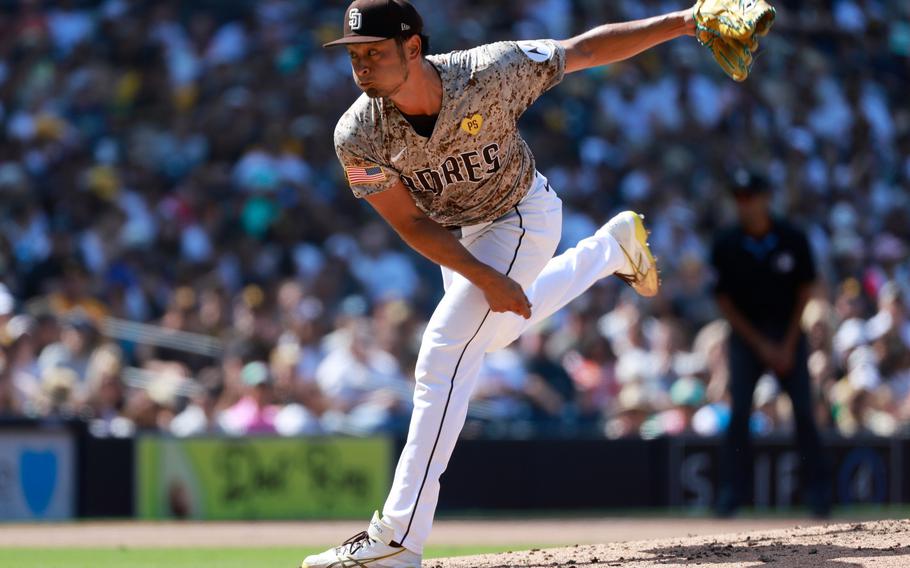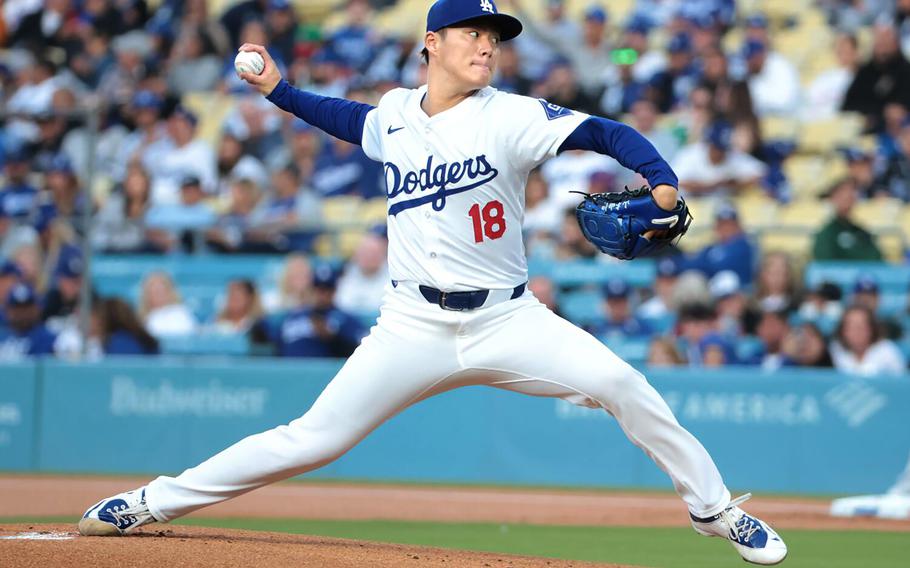Japan’s award for the top starting pitcher in baseball is named after Eiji Sawamura. (Public domain)
When the Los Angeles Dodgers and San Diego Padres meet this weekend in the MLB playoffs, each team will have an expatriate Japanese baseball star who was honored as Japan’s top starting pitcher before making the jump to the United States.
The Dodgers’ Yoshinobu Yamamoto and the Padres’ Yu Darvish have won the Sawamura Award.
It is named for Eiji Sawamura, a Japanese star pitcher of the 1930s who was killed in combat fighting U.S. troops during World War II.
Barnstorming Asia
Professional baseball teams from America first visited Japan in 1908, well after baseball had become a national obsession in the country. The pinnacle each year was the high school championships played at Koshein Stadium outside of Osaka. The ballpark still stands and copies Chicago’s Wrigley Field with the outfield walls draped in ivy.
The biggest and most famous barnstorming teams arrived in Asia in 1934 when Philadelphia Athletics owner-manager Connie Mack brought a team of American League stars. Tensions between the U.S. and Japan were already on the rise over battleship construction, American limits on oil sales and Japan’s invasion of neighboring China.
However, lucrative offers from Japanese business interests brought the American ballplayers over for a tour.
The American team included all-time greats such as Lou Gehrig, Jimmie Foxx and Charlie Gehringer. But the legend who attracted adulation wherever the team went was Babe Ruth.
Buoyed by the attention, Ruth went on a hitting rampage, hammering 13 home runs. His first homer of the series landed in Sendai Zoo, where the Japanese built a monument to the blast, and he was photographed surrounded by cheering fans, clowning with children and wearing traditional Japanese formal wear.
The Americans regularly steamrolled their way to victory against Japanese pickup teams put together on the fly to play the All-Stars. They ended the tour undefeated.
But for one day, Japan saw the sluggers tamed by a teenager.

San Diego Padres pitcher Yu Darvish throws against the Chicago White Sox at Petco Park on Sept. 22, 2024 in San Diego. (K.C. Alfred, The San Diego Union-Tribune/TNS)
The Boy and the Babe
Sawamura was a late addition to one team of locals scraped up to face the American stars. The starting pitcher was pulled after four innings of shutout ball and Sawamura took the mound.
The youngster struck out Gehringer. Then Ruth, Gehrig and Foxx. He finished with nine strikeouts but was saddled with the 1-0 loss when Ruth hit a home run in the seventh inning.
“The first real game the barnstormers have played in Japan,” The New York Times reported Nov. 21, 1934. “Sawamura fanned the major league stars and had a brilliant shutout but for Ruth’s home run.”
The final score did not overshadow the excitement among Japanese fans and newspapers in Tokyo and Osaka, which filled headlines with Sawamura’s heroics.
On the Americans’ return to the U.S., Connie Mack was asked about Japanese attitudes toward them. He admitted there was a strong sense of anti-Americanism but suggested baseball was an antidote.
“Then Babe Ruth smacked a home run, and all the ill feeling and underground war sentiment vanished just like that!” Mack said.
All-star and soldier
Sawamura went on to play with the Yomiuri Giants in the newly formed pro league in Japan. He threw three no-hitters and was the league MVP in 1937.
Relations between the U.S. and Japan soured further as Japanese troops marched across Asia, occupying much of China.
The military dictatorship that controlled Japan under the symbolic leadership of Emperor Hirohito banned many Western influences — jazz music, Hollywood films, and Western clothing and hairstyles for women.
Baseball was an exception. Military authorities told teams to drop American names and English characters from their uniforms. The Giants became the Kyojin — Japanese for giants.
The Japanese surprise attack on Pearl Harbor in December 1941 brought the United States into World War II. Ruth, by then retired, famously opened the windows of his apartment in New York City and tossed out his collection of ceramic gifts from the 1934 trip to Japan.
Sawamura and other players split time between the Army and baseball, playing each season even as American troops pushed back across the Pacific at Wake Island, Tarawa, Rabaul and Guadalcanal.
Until 1943, the Nippon Professional Baseball played 80 games. The 1944 season was only 35 games.
Death of Sawamura
Sawamura served a combat tour from 1938 to 1940 in China, then was called back into service in 1941 as part of the Japanese army’s drive to push the Americans out of the Philippines.
But most years, Japanese baseball records show Sawamura was sent home to pitch, throwing his third career no-hitter in July 1940. Sawamura was officially discharged in 1942.
However, Sawamura and other veterans were called back to service as Allied troops neared the Japanese mainland.
In late 1944, units from Sawamura’s division boarded the SS Hawaii Maru bound to reinforce Japanese forces in Borneo. The transport was making its way along the coast of Kyushu when it was spotted by the U.S. Navy submarine USS Sea Devil. The submarine’s torpedoes sent the ship to the bottom in minutes, including the 27-year-old Sawamura.
“Nippon’s greatest pitcher went to war and never came back,” wrote Robert Weintraub, author of “The Victory Season — The End of World War II and the Birth of Baseball’s Golden Age.”

Dodgers pitcher Yoshinobu Yamamoto throws a pitch against the Diamondback in the first inning at Dodgers Stadium on May 20, 2024. (Wally Skalij, Los Angeles Times/TNS)
Rebirth in Japan
After the Japanese surrender in 1945, American occupation authorities encouraged a return of baseball in the country.
The American game was still beloved in Japan, and soon, the pro leagues were playing within the rubble of Tokyo and the atomic blast wreckage of Hiroshima.
Play resumed in 1947, and a new award for the top starting pitcher, the Sawamura Award, was given out annually. Sawamura’s number 14 was retired by the Giants, and he was elected to the Nippon Professional Baseball Hall of Fame in 1959.
In the years since, the award has been won by players who would go on to careers in the United States, including Hideo Nomo and Kenta Maeda of the Los Angeles Dodgers, Daisuke Matsuzaka and Koji Uehara of the Boston Red Sox, and Masahiro Tanaka of the Yankees.
Yu Darvish, now with the Padres, won the award in 2007. Yamamoto won three consecutive awards in 2021, 2022 and 2023 before signing in the offseason with the Dodgers.
Darvish must now face Japanese star pitcher-hitter Shohei Ohtani, now with the Dodgers. Ohtani’s ability to be an ace pitcher and a leading home-run hitter has frequently drawn comparisons to a legendary American player who helped create Sawamura’s legend — Babe Ruth.